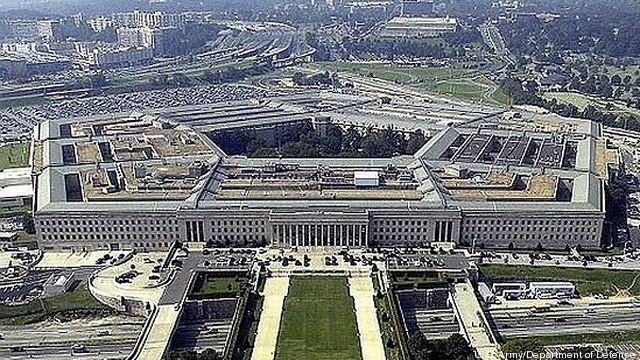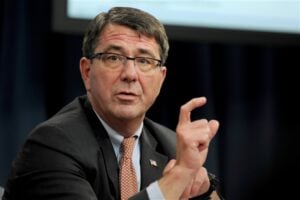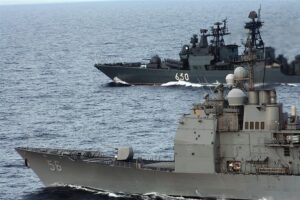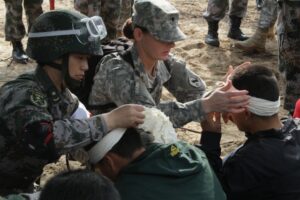
PENTAGON: After 25 years of war in the Middle East, the Pentagon’s 2017 budget is the first driven by Russia and China.
“The program has been shifted to a more acute focus on the two high-end competitors, Russia and China,” a senior defense official told Sydney in an interview ahead of Secretary Ash Carter’s budget speech this morning.
“The secretary feels strongly that we’re at a strategic inflection point,” the official said. “We’re going to have to start thinking differently for the next 25 years than we have been accustomed to in the last 25, and it’s primarily because of the reemergence of great power competition.” We must jettison assumptions like Russia being “a responsible international partner” and US forces going down to zero in Iraq and just 1,000 in Afghanistan. “None of that has come to pass.”
In his speech before the Economic Club of Washington, Carter put the case for a revamped budget simply. “Two of these challenges reflect a return to great power competition. The first is in Europe, where we’re taking a strong and balanced approach to deter Russian aggression – we haven’t had to worry about this for 25 years, and while I wish it were otherwise, now we do,” he said.
“The second is in the Asia-Pacific, where China is rising, and where we’re continuing our rebalance to maintain the stability in the region that we’ve underwritten for the past 70 years, and that’s allowed so many nations to rise, prosper, and win.”

Ashton Carter
So “what’s different about this budget…a very tight budget?” the senior defense official said. “What [we] needed to do first was refocus the program on the two high-end competitors that we have, great powers [and] let’s start to shift away…from a real heavy focus on counterinsurgency.”
“We knew we weren’t going to get any [more] money, ” the official continued: Last fall’s hard-won budget deal allocated $582.7 billion to the Defense Department, $524 billion in the base budget plus $58.8 billion in overseas contingency operations (OCO) funds.
Here’s a summary of the top weapons modernization efforts Carter outlines in his speech:
- Cyber will get “nearly $7 billion dollars in 2017 and almost $35 billion dollars over the next five years.”
- Undersea capabilities get $8.1 billion dollars in 2017, and more than $40 billion over the next five years for nine Virginia-class attack submarines over the next five years. More of them will get “the Virginia Payload Module, which triples each submarine platform’s strike capacity from 12 Tomahawk missiles to 40.”
- Counterterrorism gets $7.5 billion dollars in 2017 – 50 percent more than 2016.
- Precision munitions. Carter noted “we’re starting to run low on the ones we use against terrorists the most. So we’re investing $1.8 billion dollars in 2017 to buy over 45,000 more of them.
- Research and development spending increases for the second year in a row, up to $71.4 billion dollars. Carter highlighted work of the little-known Strategic Capabilities Office, which he created when he was Deputy Defense Secretary. (Click here for e a separate, in-depth story about SCO).
These aren’t huge sums by Pentagon standards: This isn’t a build-up, it’s a shift that stays within current toplines and force structure. “Instead of arguing a lot, trying to get a bigger force,” the senior defense official said, “let’s reshape the force so it can meet these requirements….with a specific emphasis in the program on being able to bolster conventional deterrence against our two high-end adversaries, Russia and China; being able to continue our fight in the Middle East; and making sure that we would be able to respond to Iran and North Korea.”
The four states are certainly not equal. While Iran and North Korea have been consistently hostile for a generation, Russia and China have become much more hostile of late, and they were always far more powerful. Despite all their differences, Russia and China pose some very similar threats. They both posses nuclear weapons, cyber/electronic warfare capabilities, increasingly sophisticated naval and air power, and the complex layering of long-range sensors, communications, and missiles — anti-aircraft, anti-ship, and land attack — known as “anti-access/area denial.”

US and Russian warships
“When you’re going up against top-end competitors like Russia and China, you will hear a lot about the A2/AD threat,” the official said. “The advanced capabilities that you might buy are very similar and can be used in both potential theaters of operation,” just with a maritime tilt in the Asia-Pacific and a continental emphasis in Europe.
For naval warfare specifically, Carter has ordered the Navy to cut back on the lightweight Littoral Combat Ship to invest more in destroyers, strike aircraft, and missiles.
“In the Pacific, a large surface combatant” — such as a destroyer — “is better than a small surface combatant” — such as a Littoral Combat Ship — “because it can do ballistic missile defense, it can do ASW [anti-submarine warfare], it can do all those things.” US naval forces have focused on attacking land targets, not enemy fleets, ever since the first Tomahawk strikes on Iraq in 1991, but that too is changing.
“There’s going to be a lot of stuff coming off airplanes and off ships that is going to, we believe, reassert surface dominance,” the official said. “We’re very confident in our undersea dominance.”
“We’re probably most stressed right now in the air, against these advanced SAMs (Surface to Air Missiles),” the official went on. “We’re spending a lot of money on the F-35 [Joint Strike Fighter] and the Long-Range [Strike] Bomber, which provide us the stealthy capabilities to go up against these things.
Stealth is key. “Compared to the top end competitors that we have, F-35 is better than A-10, because A-10 wouldn’t survive against a Russia or a China,” the official said. “It’s terrific in the counter-ISIL fight.”
What about ground forces? That’s a work in progress, the official said frankly. “Both the Marine corps and the Army are trying to figure out…this high technology battlefield that they might face against these high end competitors — primarily Russia, because we don’t anticipate a ground fight against China,” he said.

US and Chinese troops conduct a disaster relief exercise on Hainan Island in January, 2015
“The Defense Science Board said combined arms maneuver in 21st century will be a combination of fire and maneuver, EW and cyber on the tactical battlefield,” the first official said. “We haven’t got the operational concept yet to really tell us how to do that. Once we get that operational concept, we’ll start to make investments.”
“We have a ground force SPR this year, a ground combat Strategic Portfolio Review, and so in ’18 we’ll be making recommendations” for the Army, he said.
For example, the 2017 budget doesn’t accelerate the Army’s electronic warfare program, which on the current schedule can’t afford a long-range jammer until 2023. That struck me as at odds with both the Russians’ devastating use of EW in Ukraine and the emphasis DoD leaders have put on electronic warfare.
This year, “we really focused on air and sea EW and we focused on cyber because we felt those were the pressing needs,” the official replied. There’s about $7 billion in the budget for cyber in ’17 and $35 billion over five years.
But Deputy Secretary Bob Work’s executive committee on electronic warfare will probably make major recommendations for the 2018 budget and beyond. “The EXCOM is supposed to tell us where is our best bang for the buck,” the official said. “We’re going to be taking a look, a hard work, on what more we can do on EW this year.”
China’s new H-20 stealth bomber ‘not really’ a concern for Pentagon, says intel official
“The thing with the H-20 is when you actually look at the system design, it’s probably nowhere near as good as US LO [low observable] platforms, particularly more advanced ones that we have coming down,” said a DoD intelligence official.


























